






















Law can be a messy business, but corporate law departments need to run like a well-oiled machine. That was true long before legal technology was developed. However, anyone who’s participated in civil litigation will attest that the contrast is starker now. Attorneys obfuscate, stall and circumlocute in the zealous representation of their client. Nevertheless, their arguments have to be grounded in fact, and judges tend to accept documentation by technologies such as e-discovery, document review and contract management software as factual. A department that lacks these tools is at a disadvantage in litigation, as well as the tasks of in-house legal management.

In this issue of Today’s General Counsel we’re publishing articles that highlight ways to streamline your department’s operations using technology. Don McLaughlin makes a case for evaluating service providers’ use of document review tools as a benchmark for employing them. John Stambelos and Erik Rasmussen highlight the General Counsel’s duty to guide IT security. Other articles discuss how to present the argument for contract management software, and how to assess the department’s technological requirements. Additionally, placement specialist Thanh Nguyen devotes her column to why successful General Counsel should address the problem of succession, and Christopher Casey and his colleagues caution corporate departments regarding the DOJ’s threat to bring criminal charges for violations of Section 2 of the Sherman Act.
Bob Nienhouse, Editor-In-Chief bnienhouse@TodaysGC.com

NACD has been empowering directors and transforming boards for more than 40 years, and now we are working to prepare the next generation of boardroom leaders.

NACD Accelerate™ is a unique program designed to equip the next generation of board leaders from the ground up—offering dedicated executives the tools, support, and resources they need to take their first steps on the road to their NACD Directorship Certification® and ultimately position themselves for future board service. Prepare for the boardroom and take the first step toward your goal today.
Learn More:
nacdonline.org/accelerate
EXECUTIVE EDITOR
Bruce Rubenstein
EDITOR-IN-CHIEF
Robert Nienhouse
CONSULTING EDITOR
David Rubenstein
Stephen Lincoln
Catherine Lindsey Nienhouse
Christopher Casey
Ken Crutchfield
Melissa Geller
Sean Heck
Sean McConnell
Don McLaughlin
Terrence Miller
Thanh Nguyen Brian Pandya
Shaun Plant
Erik Rasmussen John Stambelos
Kristin Zmrhal
SENIOR EDITOR
Barbara Camm
Lainie Geary
FEATURES EDITOR
Jim Gill
EDITOR
Jessica Bajorinas
ART DIRECTION & PHOTO ILLUSTRATION
MPower Ideation, LLC
Dennis Block GREENBERG TRAURIG, LLP


Thomas Brunner WILEY REIN
Peter Bulmer JACKSON LEWIS
Mark A. Carter DINSMORE & SHOHL
James Christie BLAKE CASSELS & GRAYDON
Adam Cohen FTI CONSULTING
Jeffery Cross FREEBORN & PETERS
Thomas Frederick WINSTON & STRAWN
Jamie Gorelick WILMERHALE
DATABASE MANAGER
Patricia McGuinness
Robert Haig KELLEY DRYE & WARREN
Robert Heim DECHERT
Joel Henning JOEL HENNING & ASSOCIATES
Sheila Hollis DUANE MORRIS
David Katz WACHTELL, LIPTON, ROSEN & KATZ
Steven Kittrell MCGUIREWOODS
Nikiforos latrou WEIRFOULDS
Timothy Malloy MCANDREWS, HELD & MALLOY
Steven Molo MOLOLAMKEN
Thurston Moore HUNTON & WILLIAMS
Robert Profusek JONES DAY
Art Rosenbloom CHARLES RIVER ASSOCIATES
George Ruttinger CROWELL & MORING
Jonathan S. Sack MORVILLO, ABRAMOWITZ, GRAND, IASON & ANELLO, P.C.
Victor Schwartz SHOOK, HARDY & BACON
Jonathan Schiller BOIES, SCHILLER & FLEXNER
Robert Zahler PILLSBURY WINTHROP SHAW PITTMAN
For reprint requests, email Lisa Payne lpayne@mossbergco.com Mossberg & Company Inc.
Nienhouse Group Inc., 110 N. Wacker Drive, Suite 2500, Chicago, Illinois 60606. Image source: iStockphoto | Copyright © 2022 Nienhouse Group Inc. Email submissions to editor@todaysgc.com or go to our website www.todaysgeneralcounsel.com for more information.
CONTRIBUTING EDITORS AND WRITERSThe Nebula Partner Program at KLDiscovery empowers professional services organizations in the legal industry to expand their operations and serve clients at any scale. Nebula’s advanced technology offers a proven track record of success and flexibility in deployment models. In this partner spotlight interview, we speak with Terrence Miller, the Production and Operations Manager at BlueBear Solutions in Atlanta, GA. BlueBear joined the Nebula Partner Program in August 2021 and Terrence is happy to share his experience in the program to help other businesses in the legal industry grow.
requests were mounting. It was time to find a solution to help us address all the incoming requests. Scanning, copying, and printing work is decreasing and will eventually cease altogether. As we move away from paper, requests for hosted and managed review continue to grow.
After looking at several eDiscovery companies, we drew on our existing relationship with Keith Burke, Vice President of Global Channel Partner Sales and Legal Technology at KLDiscovery. Over the years Keith has worked with Matt and me on the production side through a network of vetted providers across the country, helping law firms get documents from one city to another. Keith has also collaborated with BlueBear Solutions’ Partner Rob Holland, who oversees trial technology solutions, so we had a robust business relationship in place already. Rather than referring the work we were unable to manage, Keith spoke to us about the Nebula Partner Program. We learned about the benefits of the program and how becoming a partner could be a catalyst in our company’s growth because of the clients and projects the program would enable us to take on.
What made BlueBear choose the Nebula Partner Program?
Would you tell us more about BlueBear Solutions as a company and describe your role there?
BlueBear Solutions has been in business since 2005. There are two areas of focus for the company, the document production side and the trial technology side. Matt Moore, Partner and Vice President of Document Solutions, and I manage the document production area. The trial technology side assists clients in the courtroom.
I started with the company in 2017 and serve as the Production and Operations Manager. As the company has grown and expanded, so has my role. We were not doing eDiscovery when I joined BlueBear Solutions, but over time, it has become part of the business and continues to grow.
Would you describe BlueBear Solutions’ selection process for an eDiscovery partner? We do litigation support and our
One of the main things that differentiated the Nebula Partner Program from other offerings is the 24/7/365 support. Another determining factor is the fact that BlueBear Solutions leverages KLDiscovery’s cloud. We did not have to purchase a huge T1 tower, which offered us significant savings.
What did BlueBear Solutions hope to accomplish by becoming a partner in the Nebula Partner Program?
Overall, we wanted to grow the eDiscovery side of our business and be able to address all the types of requests we were receiving.


From your point of view, what are the key benefits of the Nebula Partner Program?
We did not have an eDiscovery platform, and we were not able to do hosting or managed review, which limited our growth and revenue potential. Partnering with KLDiscovery has given us the ability to take on those types of jobs. We now have a platform in Nebula to process emails and all things eDiscovery, whereas before we did not have those capabilities.
Nebula is less expensive and much easier to navigate than other platforms on the market. We like that the software is user friendly and efficient. For example, in Nebula I can do core tasks at the push of a button. In other platforms, that same task would take several steps to complete. As someone who is still learning the software, Nebula makes it easier for me to perform tasks and complete client requests that much faster.
How has BlueBear Solutions’ business changed or grown since becoming a partner in the Nebula Partner Program?
Our eDiscovery business has expanded and Nebula has made it possible for us to accept these requests. Since partnering, we have brought in additional revenue that we were not able to access previously.
Would you describe the support you receive as a Nebula Partner?
The support we receive is nothing short of excellent. The exemplary service your team provides is showcased in one example I like to share. We received an after-hours email request with an overnight turnaround time. This occurred soon after we became a partner in the Nebula Partner Program and I was just starting to learn the software. For the request, I had to create search terms
in Nebula and filter emails according to those terms. The KLDiscovery associate I called helped me create the search term list, which I did not know how to do at the time, and filter emails accordingly. Not only was everything ready by the morning enabling us to turn the work around on time, this request was the first one we received from that particular client. The quick turnaround allowed us to build a relationship with the client that we still enjoy today.
In the beginning of the partnership with KLDiscovery, I had a specified
amount of Nebula learning time where I could call and ask questions about how to complete tasks such as loading and exporting data. Even today, the team always walks us through how to efficiently leverage the software and answers our questions in a timely manner—enabling us to deliver for our clients and grow our business.
Learn about the courses offered in the Nebula Innovation and Learning Academy and how they enable efficient training at scale.
“Nebula makes it easier for me to perform tasks and complete client requests that much faster.”
“Our eDiscovery business has expanded and Nebula made it possible. We have brought in additional revenue that we were not able to access previously.”
– Terrence Miller, Production and Operations Manager, BlueBear SolutionsVisit KLDiscovery’s website to learn more about the benefits of the Nebula Partner Program for Service Providers and sign up for a complimentary demonstration of Nebula at a time that is convenient for you.
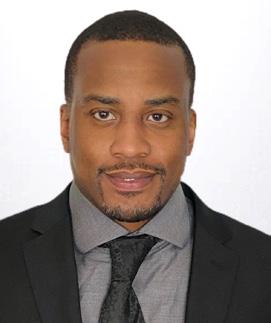

These days, the C-Suite is expecting more of legal departments, asking them to contribute to the mission and vision of the company, the same as other departments. This may lead to some resistance from the traditional legal department; however, the legal ops role can help bridge the gap between the C-suite’s expectations and the legal department’s existing workflow. To learn more, Today’s General Counsel spoke with Ken Crutchfield of Wolters
Kluwer Legal & Regulatory U.S.
So what are some ways general counsel can cooperate with legal ops to their mutual advantage?
Business goals are the first thing to start aligning on: what makes the business successful, what is the business strategy, and what are the priority initiatives and operating goals for the upcoming year.
These things help to create a common metric, a problem that everybody can get behind to solve, and from there, you can begin to get alignment between the general counsel and legal ops.
It can be helpful to solicit feedback from the stakeholders and customers of the law department: what’s important to the sales team, what’s important to the procurement group, what’s important to the GMs and the divisions. All of that knowledge could really help define some of the things that would be helpful for prioritization from a legal ops perspective. And when you get into those things, you can start to define how you make the general counsel work better and have a stronger presence in the organization as a whole.
Getting to the point where you have goals and a rough plan is great, but the next steps of learning how to work together and achieve the results you are aspiring to can take time. It is not going to happen overnight.
Still, as the relationship matures, you can begin to define priorities, explain why they are important, develop multi-year initiatives to achieve them, and measure the results.
What can the GC do to help legal ops?
Communication is essential in any relationship, and a strong relationship between general counsel and legal ops is no exception to that. A great example of this is what I would call ethnographic research, literally “a day in the life,” where legal ops would follow legal around for a full day and ask them periodically, “What are you doing here? Why are you doing that?” Those answers provide a tremendous opportunity to understand why and how an attorney is doing their work. And then by doing a standard business analysis and looking at process
improvements, you can identify what the problems and pain points are, as well as understand the language of the people in the department so that you are effectively solving their problems.
So, let’s flip that question then around and ask what can legal ops do to help GCs?
One of the goals of legal ops is to create operational structures to support an efficient, well-oiled machine. This means being able to measure and report on the results of what’s going on with concrete numbers and metrics which were defined up front. And doing this supports general counsel in a big way.
If you are a new legal operations group, taking an inventory of what the department does is a great first step. How many contracts do we review, how many sales escalations come in, how many times is there an issue with IP or trademark?
Those sorts of questions can provide a baseline of what’s going on in the department. From there, you can look into projects. How much IP activity is going on in your software company? If you are a regulated industry, what are the additional compliance aspects of a new regulation that has occurred?
If legal ops can map out what it takes to comply with a new regulation, then general counsel can explain that operationally up to the executive suite as to what the rest of the business has to do to support compliance or what the additional burden is. These are powerful things to be able to quantify and provide support to those types of initiatives.
Extending on that, what are some other projects legal ops should be undertaking?
Legal ticketing is a great example of a universal first step for a lot of organizations to consider. And then as the organization matures, additional projects that line up with the pain points and the business goals of the organization can be undertaken.
There are a lot of vendors calling with the latest trend or technology, AI, for example, that may be appropriate to apply to your process. But before adopting a particular tool or solution, you should focus on the pain point first, then look at the desired business outcomes, to have a
better understanding of what technologies can actually solve your problem.
Any final advice you would like to share?
Always start with business problems and desired outcomes. This will help inform what projects and initiatives you want to pursue, particularly as a function of time across years. A big role of legal ops is focused on process improvement, which includes people, processes, technology, and data. Understanding those things, providing the training needed for adoption, and mapping out the processes that might need to change so that effective outcomes occur are all part of the legal ops role in supporting general counsel.
These are all very important things for legal ops to consider and for the law department to ultimately act on to drive success. And if the general counsel understands this and can be a supportive executive sponsor for things that are going to be optimized, including big changes, and advocating for that, you’re much more likely to have a successful implementation and deliver on the results you’re looking for.
 By CHRISTOPHER CASEY, MELISSA GELLER, SEAN MCCONNELL AND BRIAN PANDYA
By CHRISTOPHER CASEY, MELISSA GELLER, SEAN MCCONNELL AND BRIAN PANDYA
In spring 2022, officials in the Antitrust Division of the Department of Justice (DOJ) announced their intention to revive the practice of bringing criminal charges for violations of Section 2 of the Sherman Act. But the announcement and DOJ leaders’ subsequent statements, coupled with a refusal to issue guidance, leave more questions than answers.
Section 2 of the Sherman Act outlaws monopolization, attempts
to monopolize and conspiracies to monopolize. Violations are punishable by significant fines for companies and individuals, and up to 10 years of imprisonment. The DOJ has not brought a criminal case under Section 2 since 1977, reserving criminal charges for per se Section 1 violations such as price fixing and bid rigging.
The change in policy was announced by top officials in the Antitrust Division in spring of 2022.
In response to a question at the American Bar Association’s White Collar Crime Conference in March 2022, Deputy Assistant Attorney General Richard A. Powers stated that the DOJ intends to bring criminal cases “if the facts and law lead us to the conclusion that a criminal charge based on a Section 2 violation is warranted.” In April 2022, Assistant Attorney General Jonathan Kanter, the DOJ’s top antitrust official, made several statements signaling
an intention to vigorously enforce Section 2 and to bring criminal charges where warranted.
Reinforcing the change in policy, the government revised the Justice Manual, the Department’s guidance document for prosecutors. Instead of limiting criminal enforcement to Section 1, as it had before, the manual now states that “the Department… may also bring, and has brought, criminal charges under Section 2.”
But the DOJ has refused to provide any guidance to the business community and has been unwilling or unable to provide substantive answers to questions about how it will prosecute Section 2 cases. For example, case law construing Section 2 as a criminal statute is 45
case law and old market paradigms no longer fit the modern marketplace. On January 24, 2022, Kanter complained of the “dearth of section 2 case law addressing modern markets.” In remarks to the March 2022 White Collar Crime Conference, Kanter observed that “many businesses no longer fit the models… that resulted in the development of prevailing competition policy.” On April 21, 2022, he noted that today’s market realities cannot be addressed with “assumptions embedded in out of date models or cases.” And in that same speech, Kanter identified “Address[ing] Today’s Market Realities, Not Yesterday’s” as the third point in a five-point plan to revive antitrust enforcement.
or more years old, with key substantive case law dating back to the 1940s and earlier.
Powers has stated that the DOJ will be relying on this old case law in bringing Section 2 prosecutions, rather than the more recent Section 2 case law developed in the civil context. For example, on June 3, 2022, Powers stated that “[a] long history of Section 2 prosecutions and accompanying case law can show us the way forward.” A few days later, in response to panelist questions at a webinar hosted by the American Bar Association’s Antitrust Section, Powers stated that he believed that courts would apply the older criminal Section 2 cases and not the more recent civil Section 2 cases in future criminal Section 2 cases.
These statements contradict Kanter’s previous statements that old
The point is not small. Civil monopolization cases are notoriously complex, requiring expert testimony to define the relevant product and geographic markets. A criminal Section 2 prosecution will be even more difficult, as it will require the higher “beyond a reasonable doubt” burden of proof. Powers suggested that relying on old case law will obviate the need for the “battle of the experts” that often complicates civil antitrust cases. But, even putting Kanter’s conflicting comments aside, it is not clear how case law from 50 or more years ago will translate to the modern digital marketplace.
While it seems clear that the DOJ is intent on reviving criminal Section 2 enforcement, it has not explained the conduct that it believes warrants a criminal Section 2 prosecution or
what standards it will ask a court to apply in such a case. Time will tell whether this policy change will result in actual prosecutions.
Christopher H. Casey is a partner at Duane Morris LLP. He previously served as deputy associate attorney general at the DOJ, as a litigator at the Federal Trade Commission, and as an assistant U.S. attorney. He concentrates his practice in the areas of white-collar defense and criminal and civil antitrust litigation.
Melissa S. Geller is a partner at Duane Morris, focusing on white-collar criminal defense, internal investigations and complex commercial litigation from prelitigation through appeals.

Sean P. McConnell is a partner at Duane Morris and vice-chair of the firm’s Antitrust and Competition Group. He represents U.S. and international clients on the full range of antitrust matters across a wide variety of industries.
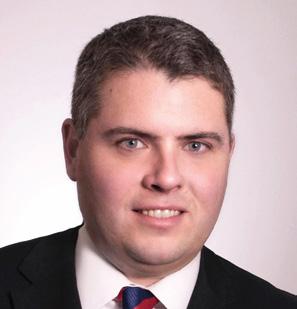

Brian H. Pandya is a partner at Duane Morris, and previously served at the DOJ as deputy associate attorney general. He litigates patent, antitrust and complex commercial cases.

For many general counsel, succession planning is either a low priority or is unnecessary. However, the point of a succession plan isn’t just about a Plan B. Succession planning is important for attracting and retaining good talent, and it’s a vital part of business continuity.
In every legal role I’ve ever held, from litigator at Latham & Watkins to in-house lawyer at PepsiCo, I’ve dealt with planning for my eventual departure. We worked out who
would handle my client case files when I went in-house, and who would manage the compliance program I built at PepsiCo after I left to go on a 12-month travel sabbatical. Good succession planning can be as simple as keeping good files so that your successor can easily pick up where you left off, routinely backing up your data and records so institutional knowledge is not lost, and discussing with leadership what kinds of resources are needed to fill your shoes. Creating a solid
• Attracting/retaining good talent. Having a thought-out succession plan signals there is a fair, equitable, transparent pathway to leadership, and one that is supportive of promoting from within as well as developing the pipeline for top talent.
• Business continuity. Identifying the points of contact and the

processes that come into play if any of the key legal leaders leave ensures the business will not be left in the lurch should there be a change in the department.
• Talent management. Once successors to the general counsel and other key roles are identified, you can work to build up their leadership skills if they’re internal.
If you’re the current general counsel, there are many benefits to planning for succession. Supporting the leaders who will succeed you builds your leadership skills. The best and most sought after general counsel are those who focus
Finally, it sets you up for success in a new role. A strong succession plan ensures a smooth transition out, as well as a smooth transition into your new company.
This approach to succession planning is counter-intuitive and takes courageous leadership. True leadership, however, is measured by the leaders you create around you, not just your own capacity and accomplishments. Don’t look at it as finding your replacement. Look at succession planning as your duty to your company and those coming up after you.
on leadership and management, not just their technical legal skill. They develop their succession plan to put the right individuals in the right places for leadership, to set the business up for success, and to ensure that the success of the legal department and the company is not fully reliant on their own presence.
A succession plan also enhances your brand. How you depart from a company is just as critical to a positive reputation in the market as how you conducted yourself while in the company. Leaving your leadership in a better position than it was when you arrived will have a significant and long-lasting impact on your reputation and career.
Thanh Nguyen is a Managing Director on Major, Lindsey & Africa’s In-House Counsel Recruiting team in the Los Angeles office. Her focus is on helping organizations find top lawyers and compliance professionals across all industries. Before assuming her present duties, she was an executive and legal director at PepsiCo, Inc., where she developed the company’s Global Anticorruption Third Party Due Diligence program, and conducted internal investigations involving potential violations of the U.S. Foreign Corrupt Practices Act. thanhnguyen@mlaglobal.com
Register for this upcoming webcast and learn from e-discovery experts on how to overcome growing data preservation challenges.

The best and most sought after general counsel are those who focus on leadership and management, not just their technical legal skill.
Anyone who has spent time managing e-discovery projects knows document review is the most expensive phase of the process. They also know that just because review is expensive doesn’t mean it’s exciting or glamorous. It’s time-consuming, repetitive work, exactly the type of work that law firms can and should optimize for efficiency and accuracy.
But many law firms have struggled with justifying the investments required to advance their internal business process optimization around document review. Add to that the fact that law firms have traditionally been reluctant to share information about their operations, and you can see why legal professionals lack the insight they need to improve their practices.
That’s no longer the case.
Exterro recently partnered with Today’s General Counsel to survey legal professionals at law firms on their document review practices. The result of that survey is our 2022 Law Firm Benchmarking Report: Trends in Document Review Services. Document review as a service offering is clearly at an inflection point.
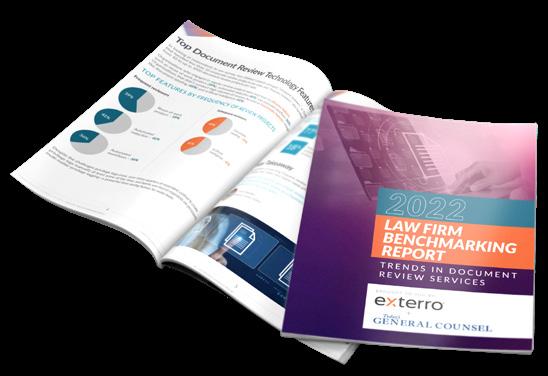
Law firms must demonstrate the value they provide with document review services or risk losing out on a growing market. Law firms and
ALSPs must recognize the trends making this a critical moment to adapt their practices and remain relevant. Let’s dig into the data to see why.
There are now more use cases for document review than ever. In addition to civil litigation, privacy regulations and cybercrime have combined to increase the need for data breach reviews, and there’s no sign of either regulatory enforcement or hacking slowing down. Civil litigation is still the number one reason why corporate clients seek document review services, according to 77 percent of respondents.
But other use cases are becoming more prevalent — and also offer more opportunity for growth. In looking to the future, law firms recognize that both internal investigations and data breach reviews are becoming more commonplace. Sixty-eight percent ranked internal investigations as the most or second-most likely type of document review cases to increase in frequency in the future, compared to 61 percent ranking civil litigation first or second. (Data breaches came in third with 36 percent)
Corporate clients see these trends as well, and in response, are increasing their capabilities to conduct reviews in-house, or at least inside technology platforms they license directly. Seventy-five percent
of in-house teams reported that they are completing the majority of their legal services in-house, and 69 percent of in-house teams reported using their designated document review software in our 2022 Pre-Litigation Readiness Benchmarking Report. Law firms and legal service providers that can’t adapt to meet these new needs risk losing business in these potential growth markets.
Ransomware attacks, malware incidents, and data breaches happen every day. Cybercriminals are increasingly targeting law firms. As caretakers of their clients’ sensitive data, there is no excuse for law firms being unprepared to respond to a data breach.
While law firms are taking more measures to secure data during document review, there’s still more that can and should be done. The surest means to avoid compromising client data is to conduct reviews inside their own secure platform — a measure that almost half (49 percent) of the in-house legal professionals responding to our pre-litigation survey (linked above) said they took.
What are the steps law firms and ALSPs should consider taking? I would suggest three.
First, start treating document
review like a business process. Start by creating standardized workflows and templates to ensure key issues are addressed consistently early in the process. Use metrics like review accuracy and cost per document to measure performance and drive optimization initiatives. In our survey, clients’ top three priorities were communication, transparency, and quality. Develop and stick to time lines and budgets for document review projects — and communicate them clearly to clients.
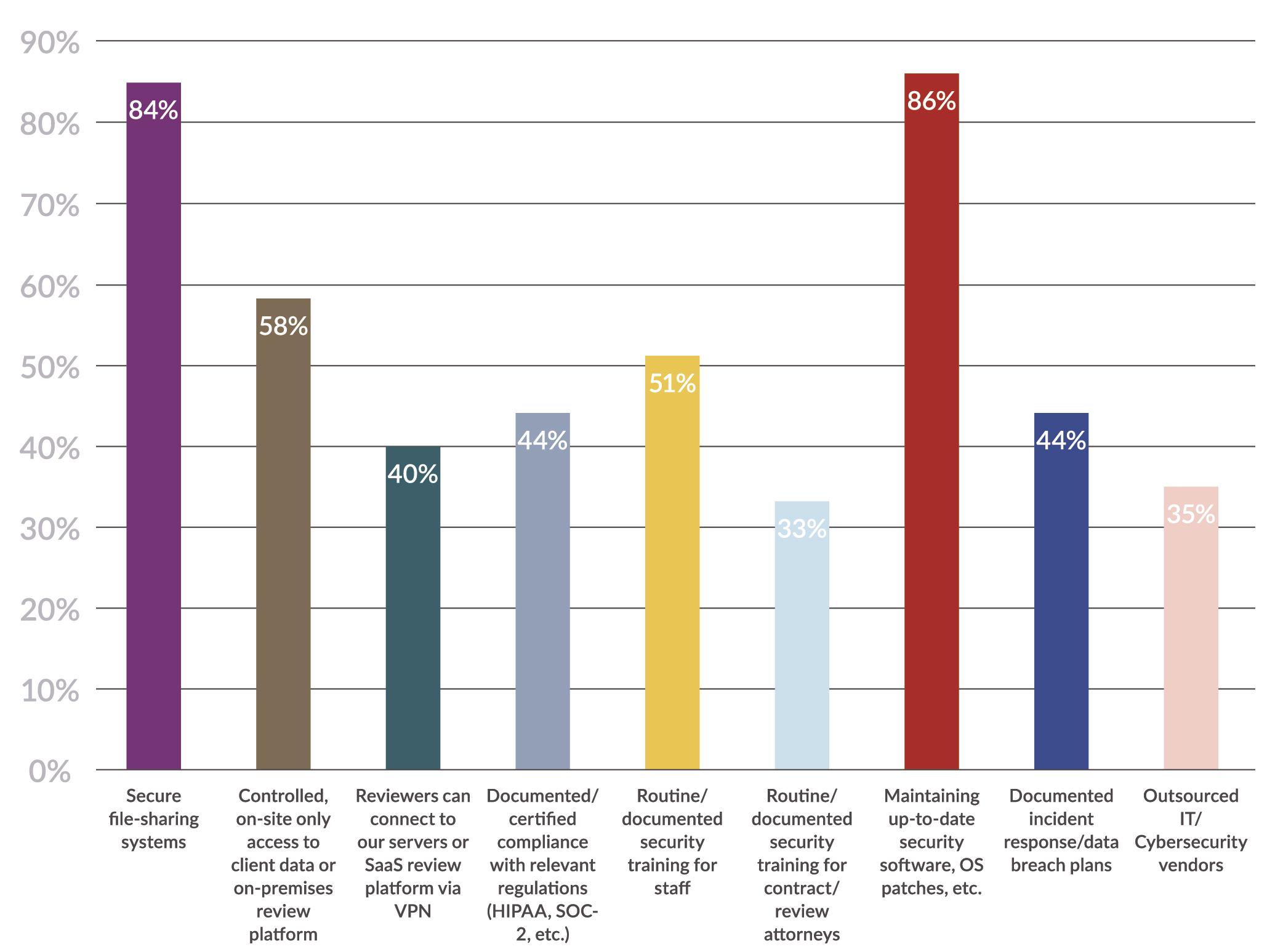
Second, develop processes and expertise in other types of document review. Internal investigations often precede litigation, but with exploding data volumes and data sources, what’s needed are fast, effective reviews. Data breach reviews focus on identifying
compromised personally identifiable information, tying it to the appropriate data subjects, and notifying them within tight regulatory time frames — often within 30 to 60 days of a data breach. These developments underscore a need to develop processes and workflows before a new matter surfaces.

Third, evaluate and improve your security posture, and that means more than just maintaining a cyber insurance policy. Invest in secure document review technology. Minimize process handoffs and data transfers between software suites — or learn to work in your clients’ platforms. Consider adding even more security measures, or hiring in-house or contract cybersecurity professionals. The reputational costs of a breach can be severe, and
there are potential regulatory consequences as well. Embracing these recommendations can ensure law firms and ALSPs are providing true value to their clients. That’s always the surest path to long-term business success.
Don McLaughlin serves as Technology Counsel at Exterro. Following years of work as a trial lawyer and corporate lawyer at a Fortune 500 company, Don founded Falcon Discovery, offering an innovative technology managed service solution for Fortune 500 legal departments. After Falcon’s acquisition by DTI/ Epiq, Don and his team nearly tripled managed services revenue, serving clients including UnitedHealthcare, CenturyLink, Fiat-Chrysler, Sony, Liberty Media and DISH Network.
 By KRISTIN ZMRHAL
By KRISTIN ZMRHAL
According to the Thomson Reuters 2022 State of the Corporate Law Departments report, “the most successful law departments will be those that leverage the momentum of the past two years to actively embrace transformative change.” This ability to adapt will affect how legal departments respond to increasingly complex regulatory frameworks, retain and motivate talent, use outside counsel, and contribute to overall business success.
So, time for a reality check. How ready to thrive is your legal department in this new world? Ask yourself these five essential questions to evaluate whether your department is set up and equipped for the future.
How much time is your department spending on lengthy, manual, or administrative tasks that could be automated or systemized? To get started with automation, it’s important to look for key processes that are step-driven, repetitive, and rules-based. Consider having legal operations track core metrics to measure the impact of your initiatives.
Remember, as your team takes back more work, such as ECA or first pass review, you will need to create more time — automation is the number one way to do so.
Do you regularly exceed budgets on core activities that do not generate value, such as high-volume transaction support? If you find the source of unforeseen costs, review the supporting processes to see how technology or workflow adaptation can help.
When it comes to handling data, risk spans everything from noncompliance to cyber breaches. Risk can also come from technologies and manual processes that rely on repetitive data entry and input, and even includes how your department works with outside counsel. Consider consolidating to one legal tech platform that can handle all aspects of ediscovery, from legal

hold production to presenting ESI data, and which can store your company’s data securely in the long term without risk to you.
Moreover, keeping your work product in-house, on one platform — as opposed to distributed across each of the law firms you employ and the systems they use — allows for the utilization of next-generation technology like cross-matter AI.
If you don’t know the answer to this question, you are at risk of losing key people from your team. One way to keep employees engaged is to promote efficiency and focus on high-value work — the right technology can help to empower these changes.
When determining what solutions can improve collaboration, save time and transform outcomes, look for a vendor who provides professional services and support along with their technology offerings. Why? Giving your team access to powerful, easyto-use technology plus industry experts not only contributes to higher job satisfaction, but also frees up time for your team to better serve their clients strategically.
Take some time to audit the way the legal team works. Identify where people are spending the bulk of their hours to help prioritize areas for technology investment, and where complex workflows and processes are making matters more difficult, time-consuming, and frustrating than they need to be. Again, consider legal technology that supports best practice efficiencies, expedites
routine tasks, and gives managers oversight on everything from budgets to performance metrics.
So, how did you do? Never fear if you’re not quite where you want to be — transformation is an ongoing journey, not a point-in-time change. Even small steps can deliver meaningful results and put you and your organization on the path to productivity, efficiency, and better legal outcomes.
Kristin Zmrhal is a leader in DISCO’s product strategy organization, where she partners with DISCO’s product delivery organization to define product priorities and feature sets. She works directly with clients to gather feedback on current and future DISCO capabilities. Zmrhal brings nearly 20 years of experience in legal technology consulting and support, having also worked at Google, Fortune 500 companies and Am Law 200 firms, and has a passion for leveraging technology and optimizing workflows to improve legal outcomes. info@csdisco.com




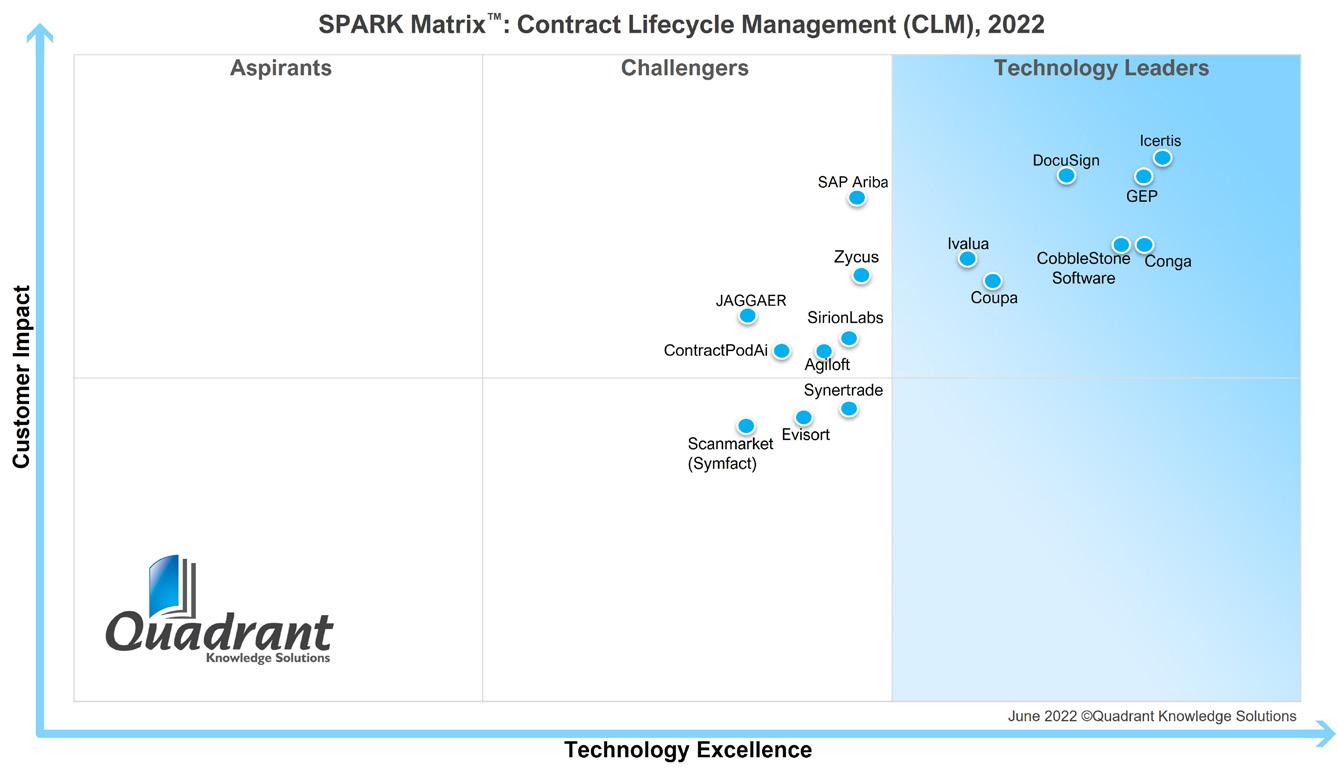
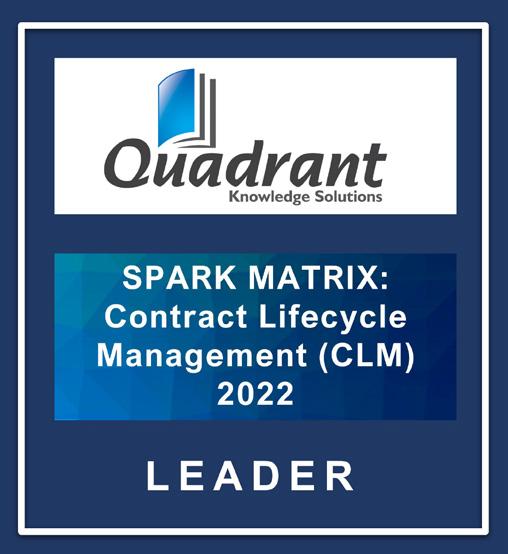

So…your expertise leads you to discover the value of contract management software. That’s great!
However, the odds are that your boss or your company’s executives don’t know what you know.
Well…you aren’t alone.
Per a recent study exploring Manitoba, Canada’s legal operations during the COVID-19 pandemic, numerous executives and business leaders with high authority failed to realize the importance of using
contract management software to aid in the survival of contract processes.
At a health forum, one disgruntled supply chain management professional said, “I was asked plenty of times, how many contracts do you have in place and who are your suppliers, and what’s your top ten? I’m running spreadsheets to do contract management, and we manage roughly 3,000 contracts here on Excel spreadsheets! It’s mind-boggling…”
Another study found that the application of smart contracts correlates with increased income and decreased risks while improving process transparency for third-party suppliers and enterprises alike.
Presenting empirical evidence and industry trends regarding the return on investment of contract management software is an exceptional start to motivating your boss to consider contract lifecycle management software. But what else can you do to make your case?

Let’s delve into three steps that will help you persuade your boss to jump on board with contract software success.
We all naturally resist change, but we understand why change is necessary. The first thing you can do to make your case is to break down the “why” behind your legal ops software recommendation.
1. Begin with the pain points: Elucidate the potential negative consequences that can and often do arise from your company’s present manual contract management process. Maybe you struggle with document version control, contract storage, and overlooked key dates. This part of the “make your case” journey can really grab your boss’s attention.
2. Delve deeper into your pain points: Further explore how these contract management pain points apply to the industry and sector in which your company functions. Prove the inefficacy of current contracting processes and how they adversely affect organizational processes. For instance, if you are a paralegal, high volumes of mismanaged contracts and agreements can increase the potential for compliance violations and missed obligations. As such, contract failure rates can skyrocket.
3. Outline the solutions to your pain points: Define which contract lifecycle management software features and functionalities can address your argued pain points. Maybe numbered
version control and audit trails, a secure contract database, and automated key date notifications and alerts are your most-needed features. Remember, you’ll need to argue for the automation of your team’s processes and the streamlining of industry projects as a whole. Always be prepared to illustrate the immediate needs and the bigger picture.
4. Further explore industryspecific features: Once the necessary features are identified you should more thoroughly explain your recommendation with explanations of industry-specific functionality and configuration options that can help you maximize contract software per your organization’s specific needs.
In order to present your case for contract lifecycle management software, you need to identify your business decision-makers, and what matters to them.
Are you speaking to Corporate Counsel focused on negotiations success, contract language, and legal compliance?
Are you speaking to a CIO focused on cyber security and stable information architecture for improved business operations?
Perhaps it’s a different type of executive.
Regardless of whom you need to persuade to consider contract lifecycle software, ensure that your argument aligns with what is important to that specific decision-maker.
The boss will want to be confident you are well-informed regarding your contract lifecycle management software recommendation. Many providers offer free contract management software demos and free trial periods to learn about how your organization would use legal operations software in practice. Here is a link to ours.
Direct and hands-on experience with the software you are recommending will significantly supplement the strength of your case. Additionally, being able to visualize the contract management software platform will bridge the gap between the hypothetical and reality.
Now that you are informed regarding how to present your case for contract lifecycle management software for your bosses and key decision-makers, it’s safe to say that you have some work to do!
Be sure to assiduously perform the steps above, as research and hard work drastically improve your chances of having your contract lifecycle management software recommendation approved and implemented.
The last thing you want to do is enter into a meeting with your boss under-prepared, so…
GET TO WORK!
Sean Heck is Content Marketing Manager at CobbleStone Software. s.heck@cobblestone software.com


Lawyers often begin their careers in private practice because they want to specialize in a specific field and be recognized as subject matter experts. However, there’s been a steady increase in lawyers leaving private practice to work in-house. Reasons include dissatisfaction with advising at arm’s length, not being part of the end result, and generally being very reactive. Instead, lawyers want to be involved in issues from start to finish and see how their advice helps to shape business outcomes.
Likewise, the business doesn’t want its legal team to mirror private practice. It needs legal to be an enabling business partner, with commercial acumen steering the business towards success. Therefore, the needs of the business and its legal team are very much aligned.
Yet research shows legal teams feel overworked, stressed, reactive, and unempowered by their tools and resources. In fact, the 2022 In-house Legal Technology Report shows 92 percent of legal teams believe they’re spending significant amounts of time on manual low-value tasks that take time and effort away from working
on larger business strategies or affect the ability to deliver services on time.
In that environment, it’s easy for the team to become disconnected from their work, each other, and the business. It’s a perpetuating cycle of overload and disconnect, which leaves lawyers feeling like they’re not realizing the reasons why they went in-house, and they’re not the valued and enabling business partner the business really needs.
This is why we developed the Connected Legal Function framework: to empower in-house legal professionals to not only optimize productivity and manage complex and high-volume work, but to maximize their connection with and the impact they have on the business. The framework comprises four steps.
Focusing on productivity enables the legal team to be more connected to their work and each other. This means optimizing legal’s ways of working to deliver legal services
more effectively and efficiently, with effortless collaboration, so the team is continually sharing and leveraging its collective legal IQ to get the best results for the business.
Focusing on productivity first frees up time to spend on optimizing the way legal engages with the business. For the legal function to be a truly valued business partner, it needs a deep and sophisticated understanding of the business environment. It’s also essential the business and legal understand what they need from each other for the business to succeed. A Connected Legal Function’s engagement with the business is open and effortless, with collaboration embedded in how they work together.
After optimizing our productivity and engagement with the business, we can focus on being proactive. By engaging with the business, the legal team can better design its processes so the business understands when and how legal needs to be involved. The team also has




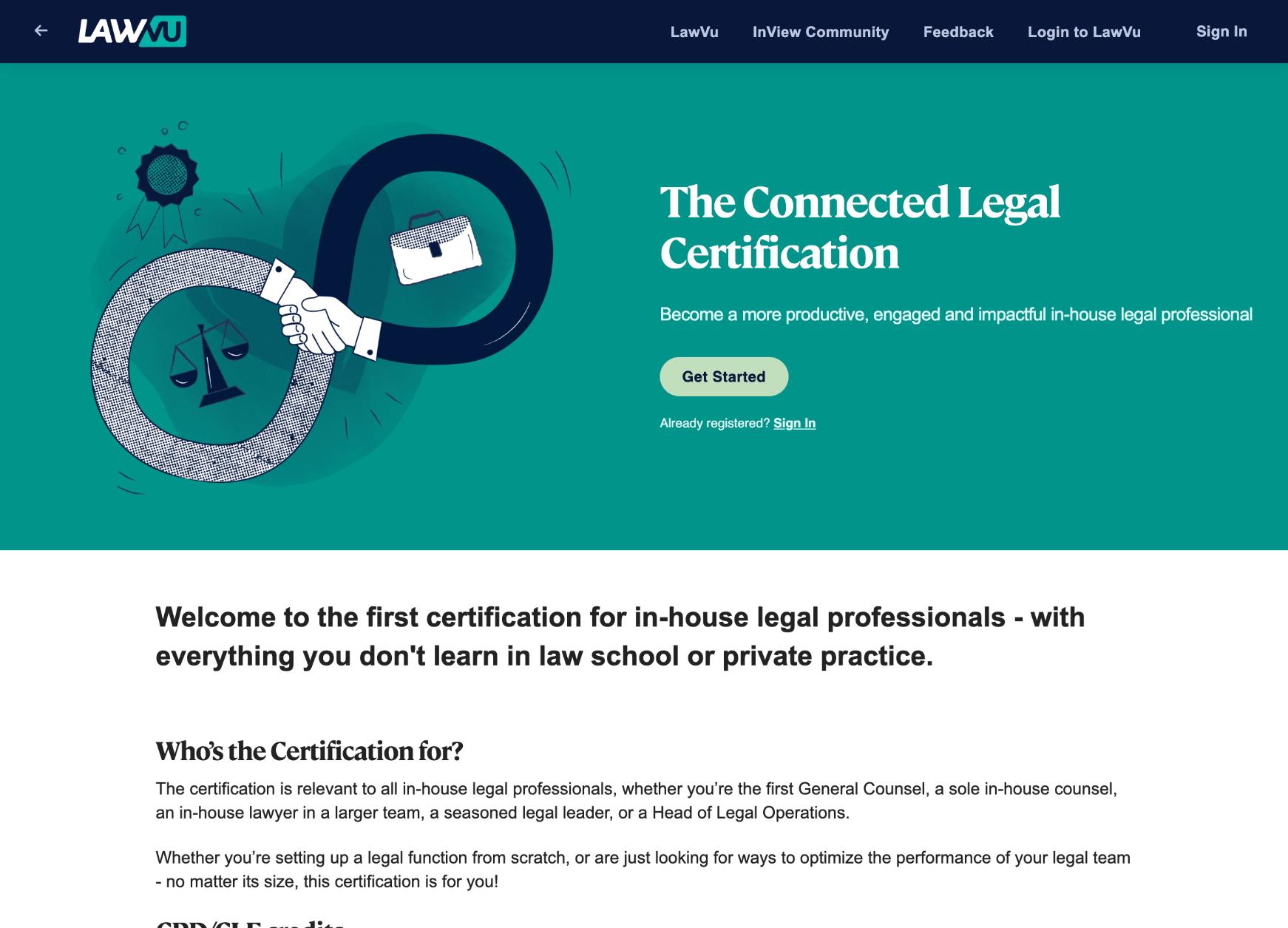
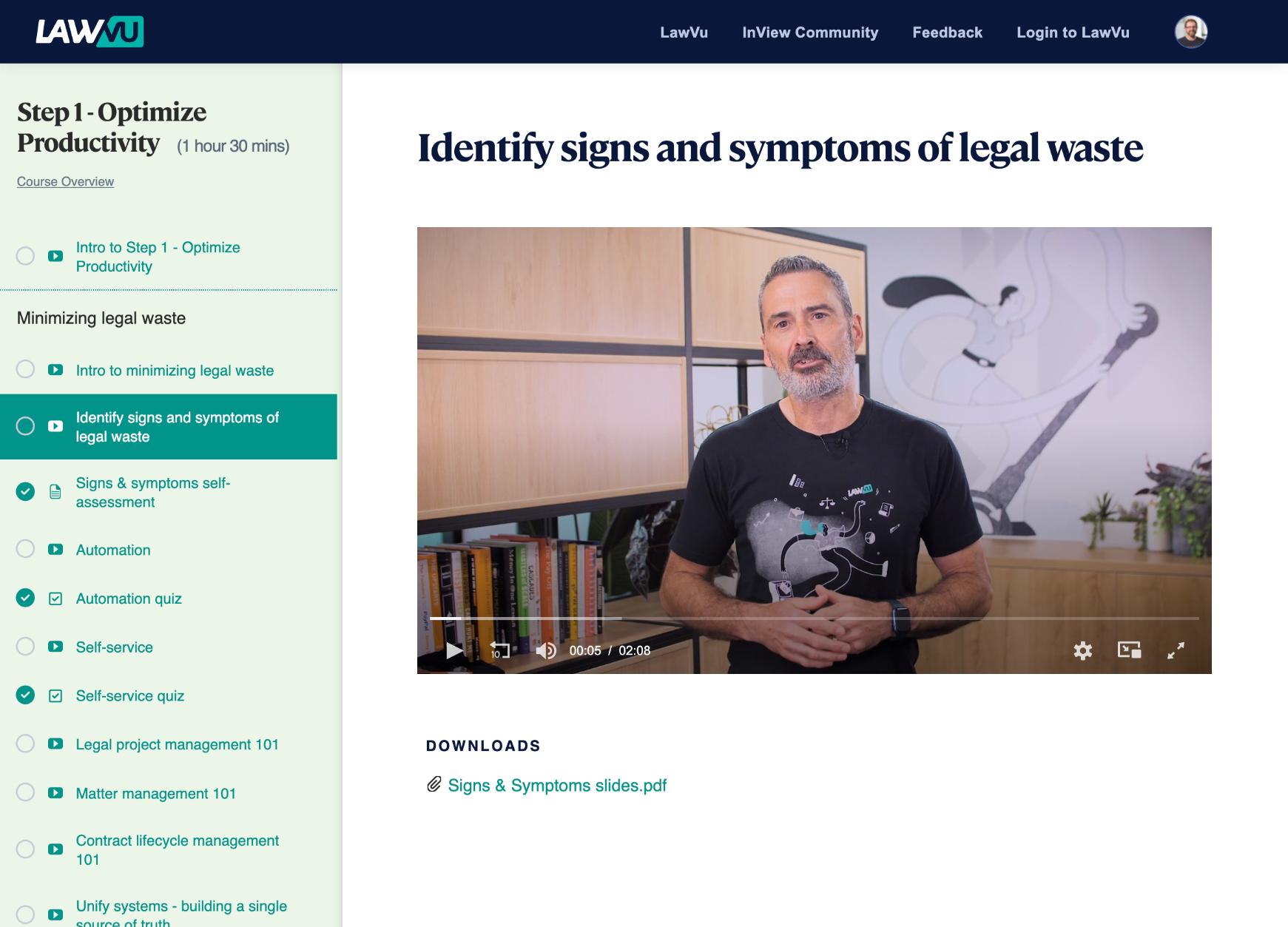

a deep understanding of the legal landscape which can affect or influence business direction, with an ever-watchful eye on the horizon to proactively navigate the business through and around legislative and regulatory change.
Step Four: Focus on Impact
Finally, we focus on the legal team’s impact on the business, so legal isn’t viewed as a cost center, but as a service that enables the business to achieve its objectives. In addition, legal knows where it adds value and makes a positive impact, developing the skills and tools to showcase that value to the business.
We understand implementing change can be difficult, especially when you’re already overloaded with work. So to make the framework more actionable, we developed the Connected Legal Certification.

The Certification is structured around the four steps of
the framework. It’s relevant to all in-house professionals, whether you’re the first General Counsel, sole in-house counsel, part of a larger legal team, a seasoned legal leader, or legal operations. It’s also relevant if you’re setting up your first legal function or want to optimize an established team, and its content may contribute towards continuing legal education.
The course covers everything from soft skills like change management, project management and stakeholder engagement, through to more practical actions such as prioritization, designing an intake system, automation of workflows and data and metrics. You’ll also learn how to get the most out of existing legal technology. It’s delivered through on-demand videos, quizzes, and templates, taking you through the four steps to become a Connected Legal Function.
By completing the Certification, you’ll develop the skills, knowledge, and tools to transform the service you provide the business. You’ll also
reconnect with why you moved in-house and be empowered to be the strategic business partner the business needs.
BEGIN YOUR CONNECTED LEGAL CERTIFICATION NOW!
To become a more productive, engaged, and impactful legal team, head over to the Connected Legal Certification, sign up, and begin your journey!
Shaun Plant is the Chief Legal Evangelist at LawVu. He is a guru in Legal Project Management (LPM), with a Masters’s degree in the subject, and provides LPM training through The College of Law (New Zealand). Shaun’s legal background spans public, private enterprises in environmental and project law. He is focused on the untapped potential of in-house counsel - seeing his role as a vehicle to elevate strategic advisory services, and enjoys transforming complex frameworks into simple and intuitive technical systems.


This webinar is designed to highlight how legal leaders can shape their strategy, find greater value in their technology portfolio, and empower their teams to achieve more amidst an uncertain economic climate.
Your DSAR Process: Are You Ready for the Nightmare Letter?
Thursday, December 8 12:00 PM CST
Join our panel of experts as we explore what employee DSARs look like and why are they so hard, what you're obligated to do, and how you can leverage technology to automate employee requests.

Wednesday, December 14 12:00 PM CST
In this webinar we will discuss how to leverage your CLM maturity stage to set goals for the year ahead, prepare for change management tailored to your organization's needs, and how to eliminate silos and generate more value from contracts


It is no surprise that organizations struggle to implement “reasonable” IT security controls. The term “reasonable” is vague, but “IT security controls” are a blend of tooling and skills used to reduce organizational risk. Implementing these controls requires determined leadership.
So which controls work and how does a leader ensure they are implemented? The answer depends on your IT leaders’ ability to correctly interpret IT policies.
Too often, there is a gap between what is written in IT policies and
what is actually implemented. Closing these gaps is the function of the general counsel. Having poorly written or inconsistently implemented policies can actually be worse than having no policies at all. You never want to discover that your written policies are misaligned with your controls during a crisis. You must have confidence that written controls are demonstrably implemented. Eliminate anything that is not.
Organizations must winnow their written IT security policies to rid themselves of aspirational
statements and maintain a core set of “must-have” policies, the most important of which is an organization’s log retention policy. It is impossible to assess the impact of a data breach — especially whether data was exfiltrated — without sufficiently detailed and immutable machine logs. Retaining accessible and immutable logs is an essential part of any reasonable IT security controls.
Device logs are not always retained according to an organization’s written retention policies. Worse, retention periods may even
be inconsistent between devices. We advise clients to retain logs for at least six months and preferably one year; most data breaches begin months before being detected.
Your IT security team must work with you to ensure organizational risk management goals are actually implemented in the underlying technology. But, IT teams are heavily task-oriented. They require a leader who understands the subtle distinction between leadership and management.
Most senior IT staff face a difficult career choice at some stage of their professional development: do they continue to hone their technical skills or become a leader? Once becoming a leader, they often lose technical skills as they grapple with new management responsibilities.
Organizations overemphasize management skills over leadership skills. We think the distinction between the two is a vital part of developing an adaptive IT security team able to implement your written IT policies. But, IT security team leaders often focus on device configuration management, rather than understanding how that device fits into the organization’s broader risk management objectives. Helping distinguish between the two is the role of a leader.
It’s vital that the general counsel guide emerging IT security leaders as they cultivate their own leadership philosophies. Help them to align their leadership philosophy with the organization’s risk management objectives.
What kind of leader they become is critical to their ability to build a competent team. For example, are they an inclusive leader? A situational leader? A principled leader?
Or are they still trying to retain their technical skills? Your guidance here cannot be understated.
Developing a leadership philosophy will help them guide their technical teams during a crisis to make informed risk management decisions before you become involved.
Next, consider circulating regular questionnaires to your IT security team, such as the Leadership Trait Questionnaire. It’s vital that you gain a nuanced understanding of which characteristics help them function better. The general counsel can help cultivate IT security leadership by spotting staff members who exhibit initiative and a desire to gain a deeper understanding of an organization’s risk management goals. IT staff who seek professional certifications might be encouraged to consider honing their leadership skills.
Help to create a professional development plan and protected time so they can pursue certifications. Consider rewarding their initiative with team leadership.
IT security professionals are in extraordinarily high demand. Despite possessing complex technical skills, they often struggle to glean an organization’s risk management objectives. Guiding technical staff to make day-to-day risk management decisions is the job of a leader.
Everyone may not agree on whether management or leadership is more important. But, it is essential to empower IT security leaders to make daily risk management decisions which require judgment and intuition. Those decisions must be aligned with the organization’s written policies and
risk management goals. The more leaders learn about organizational goals, the better equipped they are to make those day-to-day judgment calls about risk. And that affects everyone.
John Stambelos is the CIO at the Quinn Emanuel Urquhart & Sullivan. He manages the firm’s IT operations, and helps support key client relationships by working directly with their representatives during frequent IT security assessments. Before joining Quinn Emanuel, he was the founder of a cybersecurity consulting firm that helped its clients investigate large-scale data security breaches and implement strong cybersecurity programs. He was also the senior technology executive for California-based Munger, Tolles & Olson for 15 years, and a senior member of the IT leadership team for Chicago-based Katten, Muchin Rosenman for more than a decade before that. johnstambelos@quinnemanuel.com

Erik Rasmussen is a Principal at Grobstein Teeple, LLP (“GT”) and the global head of the cybersecurity and risk management solutions practice. He is also the lead on handling any internal security matters for the firm. He is an active attorney in Washington State and has almost 18 years of experience in cyber security and enforcement. Prior to joining GT, Rasmussen was a Managing Director at a global risk management firm where he led a team of cyber security experts. For more than 9 years, he was a Special Agent with the Secret Service, where he conducted dozens of domestic and international computer crimes investigations. erasmussen@gtllp.com
